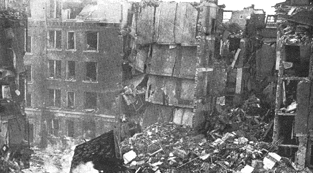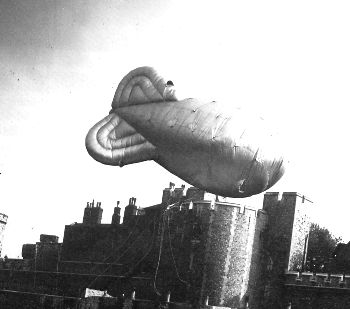The Blitz is the title given to the German bombing campaign on British cities during World War Two. However, the term ‘Blitz’ is more commonly used for the bombing campaign against London. After the failure of the Battle of Britain, the Germans attempted to bomb London into submission – a tactic used again with the V weapons campaign in 1944-45.
|
Flats destroyed by bombing |
The huge fear generated by the Guernica bombing during the Spanish Civil War, convinced many people that a civilian population could be bombed into submission. The theory was that the population, in constant fear of a sudden and violent death, would put pressure on their government to surrender. If that government did not surrender, then the population would take to the streets, riot and overthrow the government. The whole point of a sustained bombing campaign was to destroy a nation’s morale.
By mid-September 1940, the Battle of Britain had been lost by the Germans. This was the first setback Hitler had received during World War Two. The Blitz on British cities – night-time raids as opposed to daytime to enhance the fear factor – was Hitler’s attempt to destroy Britain’s morale. The attacks started on September 7th 1940 and continued to May 1941.
London was especially badly hit. At the start of the campaign, the government did not allow the use of underground rail stations as they considered them a potential safety hazard. However, the population of London took the matter into their own hands and opened up the chained entrances to the tube stations. In the Underground they were safe from the high explosive and incendiary bombs that rained down on London night after night. With one or two exceptions, their confidence was rewarded. The City tube station was hit when a bomb went through the road and fell into it. Over 200 were killed.
| “By 4.00 p.m. all the platforms and passage space of the underground station are staked out, chiefly with blankets folded in long strips laid against the wall – for the trains are still running and the platforms in use. A woman or child guards places for about six people. When the evening comes the rest of the family crowd in.” An eye-witness account. |
To start with the government underestimated the potential use of the underground stations. The government estimated that 87% or more of people would use the issued shelters (usually Anderson shelters) or spaces under stairs etc. and that only 4% of the population would use the underground stations. Each night underground stations played host to thousands of families in London grateful for the protection they afforded.
Despite blackout restrictions, the Luftwaffe had a relatively easy way of getting to London. They simply had to follow the route of the River Thames – which also directed them to the docks based at the East End of the city. Each night, the first bombs dropped were incendiary bombs designed to give the following bombers the most obvious of markers. After the incendiary bombs, came the high explosives.
|
A barrage balloon over London |
The government used its control over all forms of the media to present a picture of life going on as normal despite the constant nightly attacks. They did not show photos of people known as ‘trekkers’ – the families who would spend the night away from their homes, preferably in local woodland or a park where they felt safer from attack. Such photos were censored. An American film – “London can take it” – presented the image of a city devastated by bombs but one that carried on as normal. The narrator makes the point that “bombs can only kill people, they cannot destroy the indomitable spirit of a nation.”
However, we know that life was not quite as easy as propaganda showed. London could take it but only because there was little else they could do. Under wartime restrictions, people could not simply leave their homes and move elsewhere. The poorest in London lived in the East End and it was this area that was especially hit hard by bombing because of the docks that were based there. However, most of the families there could do little else except stay where they were unless specifically moved by the government. These families developed what became known as a ‘war-time spirit’. They adapted their lives to the constant night-time bombing.
By May 1941, 43,000 had been killed across Britain and 1.4 million had been made homeless. Not only was London attacked but so were many British cities. Coventry and Plymouth were particularly badly bombed but most of Britain’s cities were also attacked – Manchester, Glasgow, Liverpool etc.
| “When morning came we left the shelter and made our way home. There was no home. All that was left was a pile of bricks. We had nowhere to live except the shelter, and that was to be our home for six months.” A victim of bombing from Liverpool. |
The defence of these cities relied on anti-aircraft guns, searchlights and an early warning system. The Royal Observer Corps played a vital role in this as many units were based on the coast and could inform the authorities in London of impending attacks. ROC units based on the West Coast could also given early warning of German bombers coming in from Norway. As Britain had no night-time fighters then, the bombers ‘only’ had to cope with AA fire and avoiding barrage balloons and searchlights.
Within the cities, the ARP (Air Raid Precautions) wardens, police and other services organised the emergency services after a raid. The AFS (Auxiliary Fire Service) played a vital role both during and after a raid in coping with the many fires caused by incendiary bombs. The part played by the Women’s Voluntary Service is well documented.
Britain also adopted a bombing campaign against German cities. ‘Bomber’ Harris, commander of Bomber Command, was a strong believer in aerial bombardment destroying a nation’s morale – hence the attacks. However, the same ‘war-time’ spirit shown in British cities during the raids, was also shown in German.
The Blitz on Britain was called off in May 1941. Hitler had a far more prized target. In the following month, Operation Barbarossa was launched – the attack on Russia. The huge military force needed for this attack included many bombers and two-thirds of the German military was to be tied up on the Eastern Front for the duration of the war.

